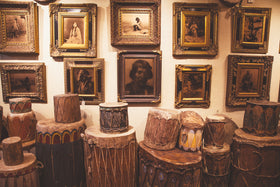Traditional Spearfishing


Native Americans Fishing In Winter, Eastman's aboriginal portfolio, by Mary H. Eastman, illustrated by Seth Eastman, U.S. Army, 1853.
Ice fishing methods have seen a lot of changes since early Native Americans were spearing fish through the ice. However, there remains a dedicated group of anglers who continue to practice these traditional spearing methods.
The first European documentation of spearfishing dates to 1763, when a fur trader noted Ojibwe fisherman using decoys to attract lake trout beneath the ice in Michigan. During the winter, Indians would cut a hole in the ice and erect a structure made from alder branches covered with canvas or blankets creating a dark house. Dark houses were essential to spear fishing because any light that reached the hole would alert the fish to the angler’s presence. A handmade decoy was then lowered into the water and jigged a foot off the bottom.

Primitive Fish Decoy with Metal Fins and Tack Eyes

Primitive Red and White Deer Bone Fish Decoy
Decoys were made in all different shapes, sizes, colors and weights. Some were hand carved from local woods such as basswood, while others were created from found objects like bone and scrap metal. The key to a decoy was not how realistic it looked but rather how well it could be manipulated to attract a fish. The motion of the decoy ultimately determines how a fish will react. Anglers quickly learned that a fish would not come into spearing range if the decoy was moving. This led to a bit of a cat and mouse game where the fisherman would jig the decoy long enough to attract a fish but would then allow it to rest when the fish was within view. Many times, a fish could take multiple passes before trying to strike the decoy. When it did, the angler had to be ready with the spear.

Hand Forged Ice Fishing Spears
Ice fishing spears came in all different configurations and have evolved over time. What started out as barbed poles tipped with bone or horn points, gave way to the hand forged iron trident still used to this day. The most common spear design featured a tip with three to five tines attached to a three to four-foot pole of either wood or iron pipe. Often the spear would have a length of rope attached for easy retrieval. It is said that eight feet is about as deep as one could throw a spear and still connect. In order to connect with a fish, the angler had to be positioned directly over it at a 90-degree angle to the surface with the tines already in the water. If the tines weren’t in the water, the initial splash could spook the fish. If the angle of the throw was off by the slightest, it could result in a miss.
Given the amount of patience needed to be successful in spearing fish along with the tight restrictions placed on the practice, it is easy to see why modern-day ice fisherman choose a rod over a spear. However, for sportsman like Minnesota resident Richard Nelson, it is not just about how many fish you take, it’s about preserving traditional practices while crafting your own decoys.

Richard Nelson - Leech Lake, MN 1990's
Richard Nelson, age 94 from Zimmerman, Minnesota is a third-generation outdoorsman, spear fishermen, and wood carver. Over the past 30 years, Cisco’s has built a good relationship with Richard. What started as the exchanging of old hunting stories and adventures developed into a strong friendship. One of Richard’s favorite sports has always been spearfishing pike and carving his own decoys has only added to the enjoyment. It is through this friendship that we have been able to acquire much of his personal fish decoy collection. In addition, Richard has “scouted” Minnesota from top to bottom and side to side supplying us with thousands of decoys for our collection.
Due to the sheer quantity of decoys, only a hundred or so are currently available online. We are continually updating our online inventory and hope to have the complete collection available on our website as well as on display at our gallery in the near future. You can view the collection by clicking the link below.




